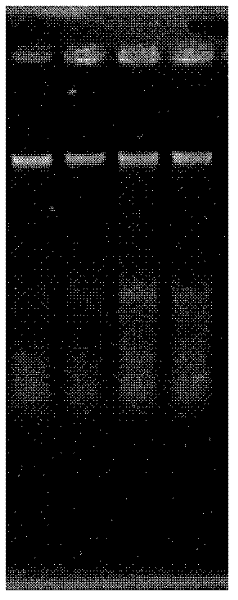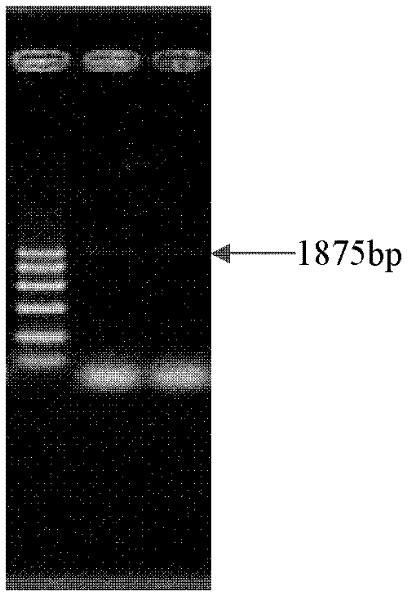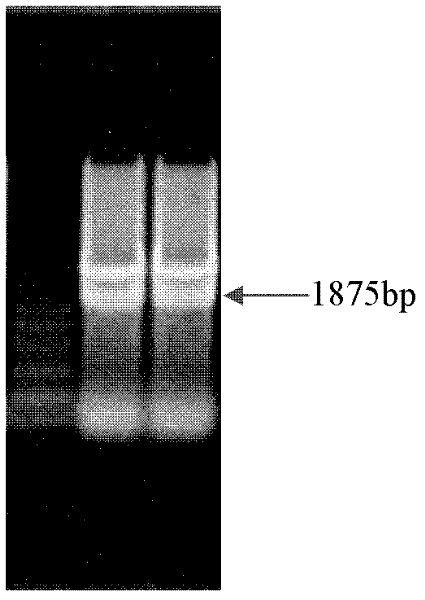Low-temperature drought induced promoter of zeamays and activity analysis
A drought-inducible, promoter sequence technology, applied in the field of low temperature, drought-inducible promoter sequence, DNA sequence, can solve the problem of few inducible promoters
- Summary
- Abstract
- Description
- Claims
- Application Information
AI Technical Summary
Problems solved by technology
Method used
Image
Examples
Embodiment 1
[0036]Example 1: Cloning of the low temperature and drought inducible promoter of the maize zinc finger protein gene ZmZFP
[0037] The promoter of the maize zinc finger protein gene ZmZFP (the promoter sequence comprises the DNA nucleotide sequence of the -1bp to -1645bp region relative to the transcription start site of SEQ ID NO: 1), in the 5' region of the maize ZmZFP gene identified in the sequence.
[0038] The maize zinc finger protein gene ZmZFP is registered in NCBI GenBank (accession number: EU963900.1), and the sequence listing shows the DNA sequence of the plant low temperature and drought inducible promoter and 5' untranslated region of the above gene of the present invention. In the list of promoter sequences in this document, the base G of the transcription start site is indicated by +1, and the base ATG is underlined in red. And use the promoter analysis website to analyze the core elements of the promoter. Promoter analysis website http: / / bioinformatics.psb....
Embodiment 2
[0043] Example 2: Construction of Plant Low Temperature and Drought Inducible Vector
[0044] The low temperature and drought inducible promoter of the maize zinc finger protein gene ZmZFP cloned in Example 1 and the 5' untranslated region ZmZFPPro (see sequence listing) of 230 bp were inserted into the vector to construct a plant low temperature and drought inducible carrier.
[0045] More specifically, the plant expression vector pCAMBIA1301 and the recombinant plasmid pMD18-T::ZmZFPPro were respectively digested with PstI and BglII, and then inserted into the PstI and BalII restriction sites of the vector pCAMBIA1301. This vector is called pCAMBIA 1301::ZmZFPPro, and is used to drive the expression of GUS gene, identified by PCR ( Figure 4 ) and enzyme digestion identification ( Figure 5 ) to obtain the recombinant plasmid of the promoter and the vector.
[0046] exist Figure 7 Among them, the gene GUS encoding β-glucuronidase was used as the reporter gene, and the s...
Embodiment 3
[0047] Example 3: Identification of the activity of a maize low temperature and drought inducible promoter
[0048] By electric shock transformation, the vector pCAMBIA1301::ZmZFPPro constructed in Example 2 was transferred to Agrobacterium tumefaciens EHA105, and the plasmid was extracted and identified by PCR ( Image 6 ).
[0049] In order to identify the low-temperature and drought-induced activity of the promoter, the method of Jefferson et al. (EMBO J, 1987) was used to treat maize embryos with low temperature (4°C) and drought and then detect the activity of GUS.
[0050] More specifically, the corn seeds are soaked to accelerate germination, and then the seeds are cut in half longitudinally, respectively induced and cultured at 4°C and 20% PEG for 24 hours, and the corn seeds are placed in the GUS detection solution at 37°C overnight, GUS detection solution: 1mg / ml X-gluc (5-bromo-4-chloro-3-indole-β-D-glucuronide), 50mM sodium phosphate buffer solution (PH=7.0), 10m...
PUM
 Login to View More
Login to View More Abstract
Description
Claims
Application Information
 Login to View More
Login to View More - R&D
- Intellectual Property
- Life Sciences
- Materials
- Tech Scout
- Unparalleled Data Quality
- Higher Quality Content
- 60% Fewer Hallucinations
Browse by: Latest US Patents, China's latest patents, Technical Efficacy Thesaurus, Application Domain, Technology Topic, Popular Technical Reports.
© 2025 PatSnap. All rights reserved.Legal|Privacy policy|Modern Slavery Act Transparency Statement|Sitemap|About US| Contact US: help@patsnap.com



